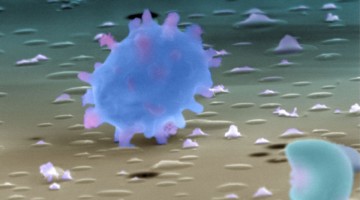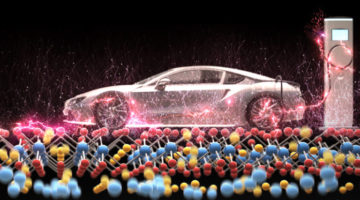Although bismuth vanadate (BiVO4) is a theoretically attractive material for electrodes in photoelectric chemical cells (PECs) used for artificial photosynthesis, it hasn’t lived up to its potential. Researchers used a multimodal approach to gain new insight into what might be happening at the nanoscale to hold BiVO4 back. Read more »
2020 Shirley Award to Honor Miquel Salmeron
By taking surface studies from ultrahigh vacuum to near-ambient pressure, Miquel Salmeron’s work at the ALS has had deep impact on a broad range of scientific questions, revealing the chemical, electronic, and mechanical properties of surfaces and interfaces on the nanometer (and often atomic) scale. Read more »
The Bottleneck Step of a Complex Catalytic Reaction
The rate-limiting step in catalysis involving oxygen uptake was identified through analysis of the reaction pathways and observations performed under operating conditions. The work lays the foundation for improving the efficiency of energy conversion and storage devices such as fuel cells, catalytic reactors, and batteries. Read more »![]()
![]()
New Catalyst Resists Destructive Carbon Buildup in Electrodes
Key challenges in the transition to sustainable energy can be met by converting CO2 to CO through the use of solid oxide electrolysis cells. But because these can suffer from carbon deposition at the electrodes, researchers have now identified and tested a new, cerium oxide–based catalyst that is more resistant to carbon buildup. Read more »![]()
Salt in the Amazon Air Comes from Local Fungi
The abundant salt in the atmosphere above the Amazon basin has long been attributed to the Atlantic Ocean. But now, using the Advanced Light Source, scientists have found that much of it originates much more locally: fungal spores in the rainforest. Pinpointing the origin will improve climate models and understanding of rainforest ecosystems. Read more »
Nanoscale Characterization of Iron and Calcium in the Alzheimer’s Brain
The amyloid plaques that accumulate in Alzheimer’s disease contain stores of iron. Using scanning transmission x-ray microscopy, researchers have characterized the iron’s chemical states in unprecedented detail. Their nanoscale analysis revealed excessive chemical reduction of the iron, which can release damaging free radicals. Read more »
From Moon Rocks to Space Dust: Berkeley Lab’s Extraterrestrial Research
Berkeley Lab has a well-storied expertise in exploring samples of extraterrestrial origin. This research—which has helped us to understand the makeup and origins of objects within and beyond our solar system—stems from long-standing core capabilities in structural and chemical analyses and measurement at the microscale and nanoscale. Read more »
Fuel from the Sun: Insight into Electrode Performance
The mechanisms limiting the performance of hematite electrodes—potentially key components in producing fuel from the sun—have been clarified in interface-specific studies under realistic operating conditions, bringing us a step closer to storing solar energy in chemical fuels. Read more »![]()
![]()
A Path to a Game-Changing Battery Electrode
If you add more lithium to the positive electrode of a lithium-ion battery, it can store much more charge in the same amount of space, theoretically powering an electric car 30 to 50 percent farther between charges. But these lithium-rich cathodes quickly lose voltage, and years of research have not been able to pin down why—until now. Read more »![]()
X-Rays Provide Key Insights on Path to Lithium-Rich Battery Electrode
If you add more lithium to the positive electrode of a lithium-ion battery, it can store much more charge in the same amount of space, theoretically powering an electric car 30 to 50 percent farther between charges. But these lithium-rich cathodes quickly lose voltage, and years of research have not been able to pin down why—until now. Read more »









